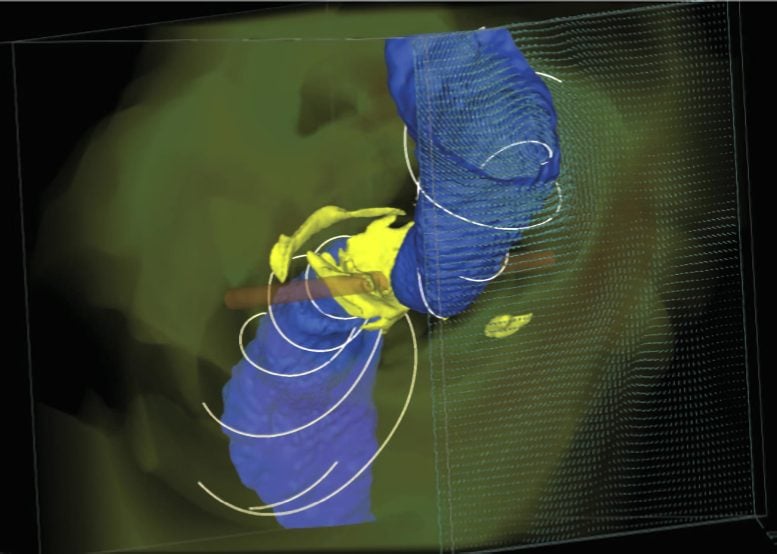
3D snapshot for an evolved Black Hole (BH) model. The disk and jet near the BH are aligned with the BH spin axis and point mostly in and out of the figure plane, whereas at larger distances the jet points roughly halfway between the BH spin axis and the disk’s rotational axis (pointing along the orange cylinder). Credit: The Texas Advanced Computing Center at The University of Texas at Austin
New 3D simulations performed on powerful supercomputers are helping researchers predicted the formation of accretion disks and relativistic jets that are shaped by the extreme gravity of black holes and by the powerful magnetic forces generated by their spin.
Voracious absences at the center of galaxies, black holes shape the growth and death of the stars around them through their powerful gravitational pull and explosive ejections of energy.
“Over its lifetime, a black hole can release more energy than all the stars in a galaxy combined,” said Roger Blandford, director of the Kavli Institute for Particle Astrophysics and Cosmology and a member of the U.S. National Academy of Science. “Black holes have a major impact on the formation of galaxies and the environmental growth and evolution of those galaxies.”
Gravitational forces grow so strong close to a black hole that even light cannot escape from within, hence the difficulty in observing them directly. Scientists infer facts about black holes by their influence on the astronomical objects around them: the orbit of stars and clumps of detectable energy. With this information in hand, scientists create computer models to understand the data and to make predictions about the physics of distant regions of space. However, models are only as good as their assumptions.
Magneto-spin alignment effect movie by Ralf Kaehler (for Science paper by McKinney, Tchekhovskoy, and Blandford 2012): The black hole spin axis, disk rotational axis, and emergent jet axis are all initially aligned. We instantly tilt the black hole spin by 90 degrees in the middle of the simulation, after which the spinning black hole (at center) reforms the powerful jet (white-blue) along the tilted black hole spin axis. The jet rams into the surrounding accretion disk (infalling hot plasma as white-red near the hole) and causes the disk to align with the black hole spin axis near the black hole. At larger distances from the black hole, the disk finally pushes back on the jet causing the jet to re-align with the outer disk rotational axis.
“All tests of general relativity in the weak gravity field limit, like in our solar system, fall directly along the lines of what Einstein predicted,” explained Jonathan McKinney, an assistant professor of physics at the University of Maryland at College Park. “But there is another regime—which has yet to be tested, and which is the hardest to test—that represents the strong gravitational field limit. And according to Einstein, gravity is strongest near black holes.”
This makes black holes the ultimate experimental testing grounds for Einstein’s theory of general relativity.
While black holes cannot be observed, they are typically accompanied by other objects with distinctive features that can be seen, including accretion disks, which are circling disks of superhot matter on our side of the black hole’s “event horizon”; and relativistic jets, high-powered streams of ionized gases that shoot hundreds of thousands of light years across the sky.
In a paper published in Science in January 2013, McKinney, Tchekhovskoy, and Blandford predicted the formation of accretion disks and relativistic jets that warp and bend more than previously thought, shaped both by the extreme gravity of the black hole and by powerful magnetic forces generated by its spin. Their highly detailed models of the black hole environment contribute new knowledge to the field.
For decades, a simplistic view of the accretion disks and polar jets reigned. It was widely believed that accretion disks sat like flat plates along the outer edges of black holes and that jets shot straight out perpendicularly. However, new 3D simulations performed on the powerful supercomputers of the National Science Foundation’s Extreme Science and Engineering Discovery Environment (XSEDE) and NASA overturned this oversimplified view of jets and disks.
The simulations show that the jet is aligned with the black hole’s spin near the black hole but that it gradually gets pushed by the disk material and becomes parallel to (but offset from) the disk’s rotational axis at large distances. The interaction between the jet and disk leaves a warp in the accretion disk density.
“An important aspect that determines jet properties is the strength of the magnetic field threading the black hole,” said Alexander Tchekhovskoy, a post-doctoral fellow at the Princeton Center for Theoretical Science. “While in previous works it was a free parameter, in our series of works the field is maximum: it is as strong as a black hole’s gravity pull on the disk.”
In the simulations, the twisting energy grows so strong that it actually powers the jet. In fact, the jet can reorient the accretion disk, rather than the other way around, as was thought previously.
“People had thought that the disk was the dominant aspect,” McKinney said. “It was the dog and the jet was the wagging tail. But we found that the magnetic field builds up to become stronger than gravity, and then the jet becomes the dog and the disk becomes the wagging tail. Or, one can say the dog is chasing its own tail, because the disk and jet are quite balanced, with the disk following the jet — it’s the inverse situation to what people thought.”
What does this have to do with Einstein and his theory of general relativity?
Astronomers are closer than ever to being able to see the details of the jets and accretion disks around black holes. In a September 2012 paper in Science, Sheperd Doeleman of MIT reported the first images of the jet-launching structure near the supermassive black hole, M87, at the center of a neighboring galaxy, captured using the Event Horizon Telescope, a very long baseline interferometry (VLBI) array composed of four telescopes at three geographical locations. It constituted a small sliver of a vast skyscape, yet the results give astronomers like McKinney, Tchekhovskoy and Blandford the hope that they will get their first comprehensive glimpse into the black hole’s neighborhood in the next three to five years.
“We’ll see the gases swirl around the black hole and other optical effects that will be signatures of a black hole in spacetime that one can look out for,” said Blandford.
The observations will either match models like theirs, or they will be different. Both outcomes will tell researchers a lot.
“If you don’t have an accurate model and anything can happen as far as you understand, then you’re not going to be able to make any constraints and prove one way or another whether Einstein was right,” McKinney explained. “But if you have an accurate model using Einstein’s equations, and you observe a black hole that is very different from what you expected, then you can begin to say that he may be wrong.”
The model Blandford and others generated using supercomputing simulations will help serve that comparative role. But they need to add one crucial element to make the simulations meaningful: a way of translating the physics of the black hole system into a visual signal as it would be seen from the vantage point of our telescopes, billions of light years away.
“We’re in the process of making our simulations shine, so they can be compared with observations,” McKinney said, “not only to test our ideas of how these disks and jets work, but ultimately to test general relativity.”
Reference: “Alignment of Magnetized Accretion Disks and Relativistic Jets with Spinning Black Holes” by Jonathan C. McKinney, Alexander Tchekhovskoy and Roger D. Blandford, 15 November 2012, Science.
DOI:10.1126/science.1230811









Be the first to comment on "Supercomputer Simulations Present a New View of Black Hole Jets and Accretion Disks"